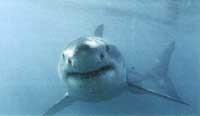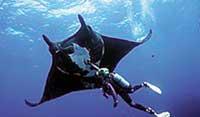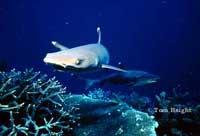Fish without thorns
Although experts' knowledge of biology and evolution of cartilaginous fish is growing, it is still very scarce. Lately many new discoveries have been made, most of them somewhat surprising.

Sharks and rays are very old species, they are about 300 million years old. Despite their apparent difference, they have more than one common characteristic: the cartilage skeleton, the special skin, and between 5 and 7 gills open to the outside, on the flanks of sharks and in the belly in the case of rays. Both sharks and rays have their mouth in the belly and face in the front. Both fish have a superb aroma and vision. Sharks and rays have the same breathing system, collect water from the hole called a spiral and take them to gills. In the case of sharks the spiral is in front of gills, in the case of rays, after eyes.
As has been said, the biggest difference between sharks and rays is in appearance. Sharks have elongated, hydrodynamic body. For this reason, most live in open water, without approaching the seabed. They top the elongated body with two-lobed tail, usually asymmetric. They have a pair of eyes on the sides of the head and, except in some race, have no eyelids. Sharks have many teeth, which when they fall – in most cases – come out again. However, sharks living near the bottom of the sea, once their teeth fall, do not come out again.
Unlike the body of sharks, the stripe is flat, so rays live on the seabed. They also have cracked tail. The stripes also have a pair of eyes, but on the back and with the eyelids. In the yew count the rays are not as lucky as the sharks, they fall when they fall and it is, they do not come out again.

As for the type of fin, between rays and sharks you can find everything: they have on the chest, on the sides, on the back, and on the back, in the cracks and some sharks. If the types of fins are abundant, let's not say the size of the rays and sharks, if they are very small and if they are very large. The largest shark is the whale shark, which can reach 12 meters in length and the dwarf shark, the smallest, about 15 centimeters. The biggest beam is the blanket, which can reach 7 meters.
Living habits

Although there are exceptions, most cartilaginous fish are carnivores. Depending on the type of habitat in which they live, they usually have a denture of this type, being carnivorous or not. When trying to eat everything, the food of sharks is very rich - fish, birds, turtles and crustaceans. As curiosities, among the sharks there are three species -Cetorhinus maximus, Rhincodon typus, and Megachasma pelagies- that filter the sea water to feed themselves, so this type of sharks have also been called planktonic. There are also parasitic sharks -of the genus Isistius. They are usually very small and get food at the expense of other large fish, larger sharks, whales or sea cheese. Fish catch most of their food from the seabed - molluscs, cephalopods, underground freckles - or absorb plankton and fish, like blankets.
As predators, sharks play an important role in the ecological balance of the sea. By their eating habits it can be said that they are health caretakers, because by eating sick or weakened fish, they are able to stop the spread of diseases.
As for reproduction, both fish and sharks have internal fertilization. The fertilization males have under the abdominal fins a couple of structures -pterigopodia or penises. Sharks of one species or another can produce eggs or embryos, while all species of rays are multiplied by eggs.

In all the seas of the world you can find sharks and rays. In addition to the seas, some species have adapted to live in fresh water. Pelagic sharks that swim at high speed, away from the backgrounds, are cosmopolitan, as they travel all the seas of the world. Depending on the temperature of the water set limits or enclosures that move geographically.
To be able to swim, bony fish use a gas-filled swim bladder, while sharks have plenty of oil in the liver and thanks to it and other balance strategies, they are excellent swimmers. Sharks can reach a speed of 60 kilometers per hour.
To date, 350 species of sharks and 470 species of rays have been identified. In view of the figures it cannot be said that they are few, but the population of sharks and rays is now in danger by human action, as on other occasions. And it has been a matter of a decade to move from being abundant to being part of the lists of threatened species. If no decisive action is taken, important treasures for science and life in the seas will be lost.
Published in 7
Buletina
Bidali zure helbide elektronikoa eta jaso asteroko buletina zure sarrera-ontzian











